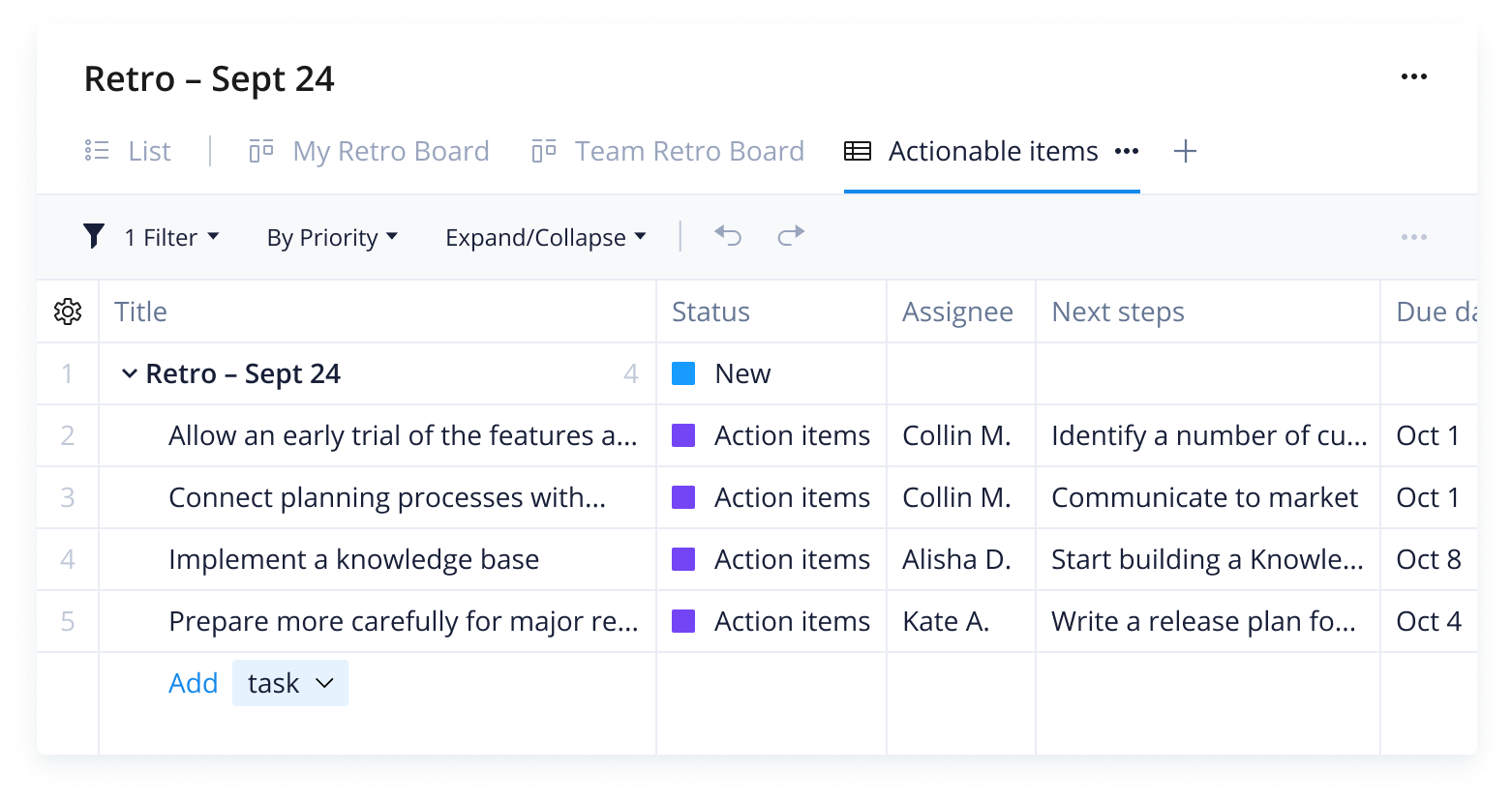Scrum isn’t a niche practice anymore. In fact, Scrum powers 87% of Agile teams, which makes it one of the most influential habits in project management today.
Yet influence does not guarantee effectiveness. Scrum meetings can be the anchor that keeps a team aligned and responsive, or they can dissolve into a hollow ritual that consumes time without creating value. The difference lies in how they are structured and facilitated.
This article explains Scrum meetings, why they matter, and how to run one that consistently sharpens focus and sustains momentum.
What is a Scrum meeting?
A Scrum meeting is a structured event in the Scrum framework where teams align, plan, and adapt their work. These meetings, also called ceremonies, guide the rhythm of a sprint by keeping communication open and progress visible.
Scrum itself is a framework within the Agile project management methodology, and it emphasizes frequent, direct conversations to share information and respond quickly to change. Therefore, Scrum meetings are the practical expression of that principle, which ensures teams remain transparent and adaptable throughout product development.
The four primary Scrum meetings are sprint planning, daily Scrum, sprint review, and sprint retrospective.
Types of Scrum meetings
Scrum meetings are not just a filler on the calendar. Each one has a clear purpose, and together they create the rhythm that keeps Agile teams moving forward with focus and adaptability.
There are four primary types of Scrum meetings:
- Sprint planning
- Daily Scrum
- Sprint review
- Sprint retrospective
Sprint planning
Every sprint begins here. The team and product owner decide what to tackle, shape the sprint goal, and map the path ahead.
Daily Scrum
This is your team’s daily checkpoint. In 15 minutes, members surface progress, flag blockers, and recalibrate. It is quick by design but powerful in impact by keeping small misalignments from becoming major roadblocks.
Sprint review
At the end of the sprint, the spotlight turns to the product. The team presents what they have built, stakeholders give feedback, and everyone aligns on what comes next. It is a collaborative moment that connects delivery with real-world value.
Sprint retrospective
A retrospective offers space for looking inward. The team reflects on how the sprint went, identifies what worked well, and calls out what needs to be refined. Retrospectives fuel continuous improvement and make sure each sprint is sharper than the last.
How to run a Scrum meeting
Running a Scrum meeting well comes down to structure and consistency. A clear agenda ensures that time is used effectively, and a steady format helps the team know what to expect each time they meet. While the details vary depending on the type of Scrum meeting, there are some universal practices that keep discussions productive.
- Start with the goal
Each meeting should begin with a reminder of its purpose, whether that is setting sprint priorities, sharing progress, or gathering feedback. This keeps the conversation focused and prevents it from drifting. - Keep it concise
Scrum meetings are designed to be time-boxed. Setting a limit encourages participants to prioritize what is most important and avoids long digressions. - Encourage equal participation
Every team member should have space to speak. Creating room for different perspectives not only improves alignment but also uncovers risks or opportunities that might otherwise be missed. - Document outcomes
Even in short sessions, it is useful to capture next steps or decisions. A quick summary helps the team stay accountable and makes it easier to track progress later.
When facilitated with these practices in mind, Scrum meetings become reliable touchpoints that maintain alignment and keep the team’s focus where it matters most.
Scrum meeting vs. standup
Scrum meetings and standups are often mentioned in the same breath, but they are not identical. The difference lies in scope.
Aspect | Standup | Scrum meeting |
Framework | Used across Agile approaches (Scrum, Kanban, Lean, hybrid) | Specific to Scrum methodology |
Frequency | Typically daily | Varies: Includes daily Scrum, sprint planning, review, and retrospective meetings |
Purpose | Quick updates and blockers | Full framework for planning, alignment, review, and improvement |
Participants | Team members, sometimes managers | Scrum team (product owner, Scrum master, development team) |
Scope | Narrow, focused on day-to-day tasks | Broader, covers both daily alignment and sprint-level planning and reflection |
A standup is any short, focused meeting where team members share updates and surface blockers. It is used across many Agile practices and is not tied to a single framework. Teams working in Kanban, Lean, or hybrid models often run standups because the format is simple and effective.
A Scrum meeting, on the other hand, belongs to the Scrum framework specifically. The daily Scrum is one type of Scrum meeting and looks similar to a standup, but Scrum also includes other ceremonies such as sprint planning, reviews, and retrospectives. These meetings create a broader structure that shapes how work is planned, delivered, and improved.
A standup is a tool that can fit into almost any Agile workflow, while Scrum meetings form a complete operating system for teams that have adopted the Scrum framework.
Common mistakes in Scrum meetings
Even seasoned teams fall into the same traps, and those missteps weaken the value Scrum meetings are meant to deliver. These errors are not limited to the daily Scrum; they span every ceremony.
Here are four recurring mistakes that dilute focus and waste time:
- No clear agenda or purpose: Meetings that start without a defined objective leave attendees unsure of what success looks like. Without clarity, conversations stagnate, and time slips away.
- Meetings that drag on: Scrum ceremonies are time-boxed for a reason — to enforce discipline and drive efficiency. When sessions bleed beyond the intended duration, they lose their impact and fade into background noise.
- Participation imbalance or silence: If only a few voices dominate, or if team members stay quiet, critical perspectives and early warnings go unheard. A Scrum meeting should surface insights from the full team, especially from those on the front lines of delivery.
- No follow-through or documentation: When decisions, action items, or blockers aren’t recorded and revisited, the meeting becomes talk without results. Teams get stuck repeating the same issues without real progress.
In the article, “The Death of Agile: Why Tech Giants Are Abandoning Scrum and What They Use Instead,” the author observes that some leading tech organizations are quietly abandoning Scrum’s formal structure in favor of more outcome-focused, flexible approaches.
This serves as a reminder that even Scrum itself must evolve to remain effective, and that the routines we build should serve our goals, not become goals in themselves.
Wrike use cases for Scrum meetings
Wrike serves as the operational layer that supports every Scrum ceremony. It keeps discussions grounded in real information, ensures action items do not disappear, and provides leaders with visibility that goes beyond a single sprint.
Planning with confidence
Sprint planning becomes more straightforward when the backlog, priorities, and capacity are all visible in one place. Teams can commit to the right amount of work without guessing, and leaders can track how planned work aligns with broader goals.


Staying aligned daily
For daily Scrums, Wrike gives every team member an instant view of task status, blockers, and ownership. Because the updates are already captured, the discussion can focus on decisions rather than updates.
Gathering feedback seamlessly
During sprint reviews, Wrike makes it simple to share the latest work with stakeholders, collect input directly in context, and turn that feedback into actionable tasks without losing momentum.
Driving continuous improvement
Retrospectives benefit from Wrike’s reporting and dashboards, which highlight trends and bottlenecks across sprints. Teams can quickly spot what is slowing them down and agree on improvements backed by data, not just instinct.


Keep every sprint on track
A well-run sprint meeting keeps teams aligned, clears blockers early, and turns plans into tangible progress. With Wrike, you can capture action items, update tasks in real time, and keep every sprint visible from planning to review.
Bring focus to your next sprint. Try Wrike to streamline standups, track commitments, and keep your team moving forward.
Not exactly. A standup is any short check-in meeting, while the daily Scrum is a formal Scrum ceremony with a specific purpose: Aligning the team on progress toward the sprint goal.
A Scrum meeting is a structured event within the Scrum framework where teams plan, align, review progress, or reflect on their process.
Scrum is not an acronym. The term is borrowed from rugby, where a “scrum” represents coordinated teamwork to move the ball forward.
A sprint meeting usually refers to sprint planning, which sets the work and goals for the sprint. A Scrum meeting is any of the four ceremonies that make up the Scrum framework.


